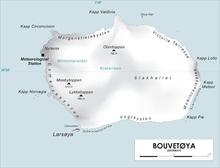Larsøya
Appearance

Larsøya,[1][2][3][4] sometimes anglicized as Lars Island, is a rocky island, less than 0.2 nautical miles (0.4 km) long, which lies just off the southwestern extremity of the island of Bouvetøya in the South Atlantic Ocean. It was first roughly charted in 1898 by a German expedition under Carl Chun. The Norwegian expedition under Captain Harald Horntvedt made a landing on the island from the ship Norvegia in December 1927, and named it after Lars Christensen, sponsor of the expedition.[5]
See also
References
- ^ "Larsøya". Norwegian Polar Institute. Archived from the original on 10 May 2012. Retrieved 8 May 2012.
{{cite web}}: Unknown parameter|deadurl=ignored (|url-status=suggested) (help) - ^ Barr, Susan (1987). Norway's Polar Territories. Oslo: Aschehoug. p. 59. ISBN 82-03-15689-4.
- ^ P. E. Baker (1967). "Historical and Geological Notes on Bouvetøya" (PDF). British Antarctic Survey Bulletin (13): 71–84. Archived from the original (PDF) on 8 May 2012. Retrieved 8 May 2012.
{{cite journal}}: Unknown parameter|deadurl=ignored (|url-status=suggested) (help) - ^ Rubin, Jeff (2005). Antarctica. Lonely Planet. p. 155. ISBN 1-74059-094-5.
- ^ "Lars Island". Geographic Names Information System. United States Geological Survey, United States Department of the Interior. Retrieved 2013-06-03.
54°27′11″S 3°18′54″E / 54.45306°S 3.31500°E
![]() This article incorporates public domain material from "Lars Island". Geographic Names Information System. United States Geological Survey.
This article incorporates public domain material from "Lars Island". Geographic Names Information System. United States Geological Survey.
